Home Improvement
Why Do You Install The Sliding Gate Automation In Your Commercial And Residential Area?
12:49 AM
For heavy duty applications, sliding gate automation is highly recommended. They are also very suitable for industrial gates. They contain certain characteristics which make them very popular among people. Automatic sliding gates are well known for their impeccable finish, easy installation, great maintenance, automated operation and for consuming low power. Following are some of the features of sliding gate automation:
 |
| Sliding Gate Automation |
How to install the Sliding Gates in a Proper Way?
- In order to provide the required thrust and silent operation, these gates are equipped with an adjustable mechanical clutch.
- Various irreparable electromechanical units are provided for ensuring that the gate is locked securely. A pass key is also given, which, at the time of electrical failure, provides a release for the manual operation.
- Precise adjustment and safety are provided to the electric motor with the help of inbuilt switches present in a scheduled or timed electric system. The electronic control panel accepts safety accessories like optical beam centres, magnetic cards, and other optional controls.
Design and Mechanism Combined to provide Maximum Utility:
- A sliding gate generally consists of a single gate. This gate operates on a track along with a ratchet. A narrow and long space is needed for sliding during the closing and opening phase. Sliding gate automation is ideal for providing protection to entrances placed uphill and wide entrances.
- The design of the motorization is such that it controls the automatic operation of the gates with the help of the leaves. The weight of the leaves is four thousand kilograms, and they ensure a reliable and long-lasting performance, along with maximum functioning safety.
How does the Sliding Gate Automation Work?
The following provides a list of elements that make up a typical automatic sliding gate:
- Radio Controls:
The radio control consists of a transmitter. In order to activate the gate, the control device that is used most commonly is the transmitter. The commands in the control unit are memorized by channels or keys present in the transmitter. These channels or keys are powered with the help of an internal battery. In order to operate, a specific receiver must be combined with the transmitter. The receiver is also equipped with one or more keys or channels for receiving signals that are transmitted by the transmitter.
- Proximity readers and switches:
The automation can be activated by using a proximity reader for the transponder cards or by means of a digital switch or a key.
- Gear motors for gates:
The movement of the sliding gate automation is enabled with the help of the motor acting on the gate. It can be mounted externally or underground and can be double or single.
 |
| Sliding Gate |
Know about the Control Units and Safety Devices:
- Control units:
In order to control the motors, various electronics are present in the control unit. This unit is used for activation of the gate. There are various types of control units. They can be either sophisticated ones that contain advanced functions or can be extremely simple ones.
- Safety devices:
There are two safety devices present in the installation of sliding gate automation. These are photocells and courtesy lamps and flashing lights. Photocells are detectors that sense a presence and enables detection of obstacles within the automation's radius of operation. When an obstacle is detected, a pulse is sent from photocell to the control unit, which results in the blocking of the movement of automation by using motors. Improved safety is guaranteed by these devices when compared to the manual gates.
The courtesy lamps and flashing lights are used for the indication of all movements of the automatic sliding gates, and also helps in increasing visibility for those situated in the area. Visit the link for more ideas or information about Sliding Gate Automation.






0 comments